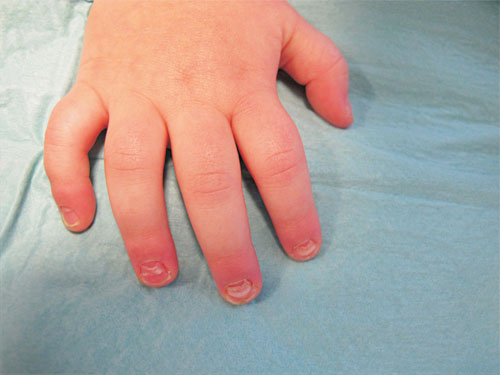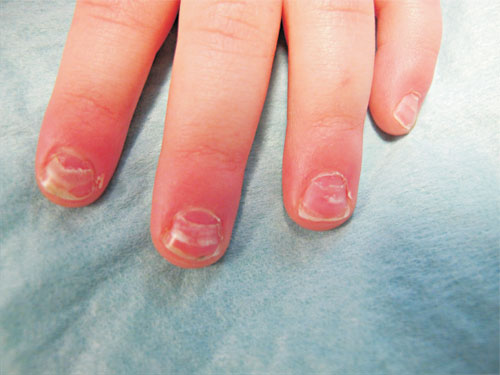|
|
|
Indian Pediatr 2014;51: 677 |
 |
Onychomadesis
|
*Elvira León-Muiños and Benigno
Monteagudo-Sánchez,
Departments of *Pediatrics and Dermatology,
Hospital Arquitecto Marcide, Avenida Residencia SN,
15405 Ferrol (A Coruña). Spain.
Email:
[email protected]
|
A 2-year-old girl developed Hand, foot, and mouth disease
(HFMD) with a self-limiting episode of fever, palmoplantar
vesicular lesions and small aphthoid ulcerations of the oral
mucosa. Approximately one month later, she presented with
onychomadesis of all fingernails of both hands (Figs.
1 and 2). About six weeks later,
complete resolution occurred spontaneously.
 |
|
Fig. 1 Onychomadesis of all
fingernails of the right hand.
|
 |
|
Fig. 2 Nail plate shedding
on the first, second, third and fourth fingers of
the left hand.
|
Onychomadesis is a reversible, painless,
non-inflammatory condition in which there is proximal
shedding of the nail plate from the nail matrix. It can
occur in fingernails, toenails or both. It may be secondary
to systemic disorders, high fevers, bullous dermatoses,
Kawasaki disease, infections (streptococcal infections and
measles), zinc deficiency, local trauma, acute paronychia,
and drug reactions. In addition to these causes, many cases
are idiopathic. HFMD is a common pediatric viral illness
that is characterized by vesicular eruptions that involve
the palms, the soles, and the oral cavity. The median
latency period between HFMD and onychomadesis is 40 days.
The mechanism of nail matrix arrest after infection remains
unclear. Transverse leukonychia and Beau lines reflects
milder interruptions in ungula growth and may occur
simultaneously in the same patient or a result of the same
disease process.
|
|
|
 |
|

